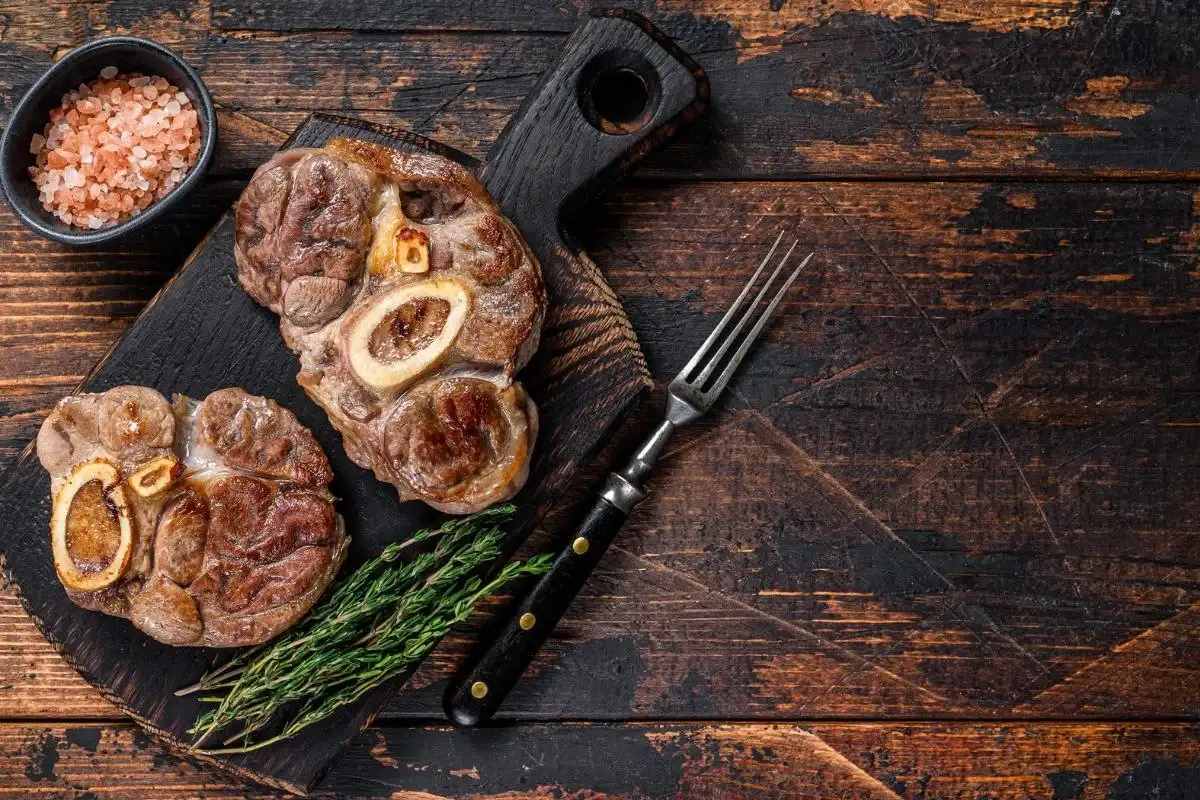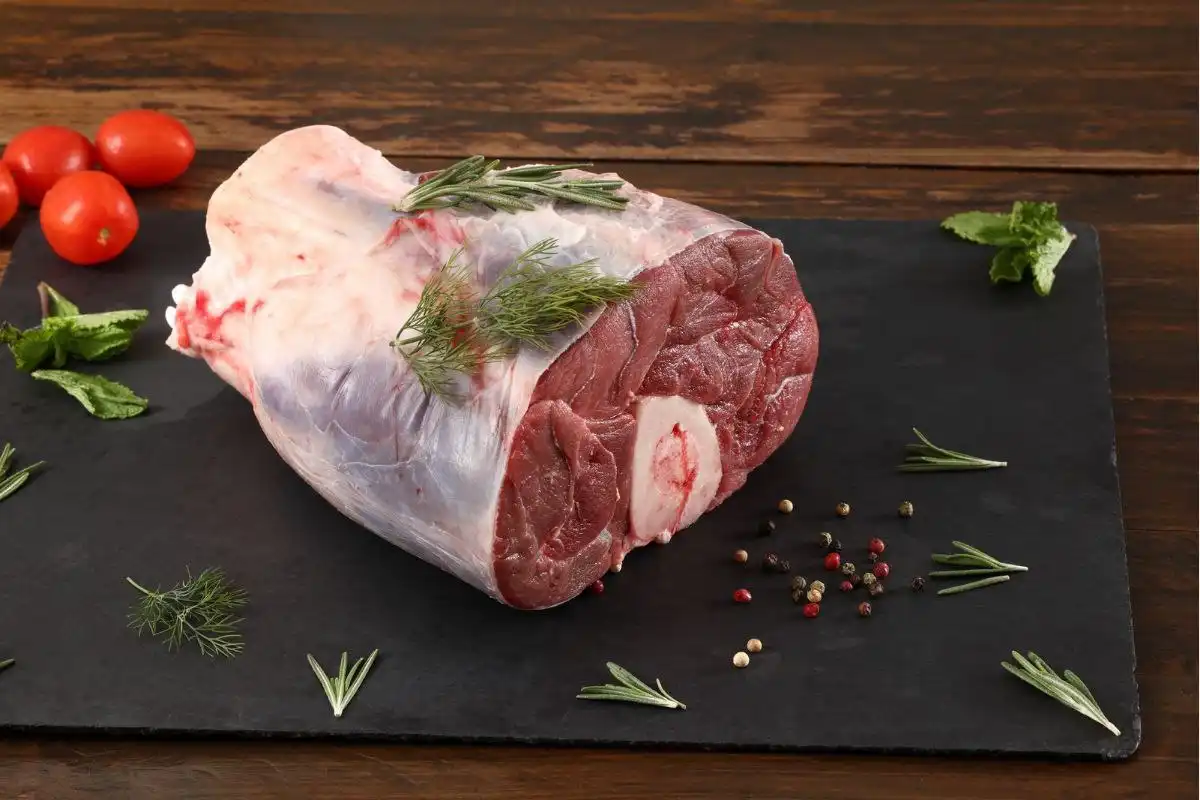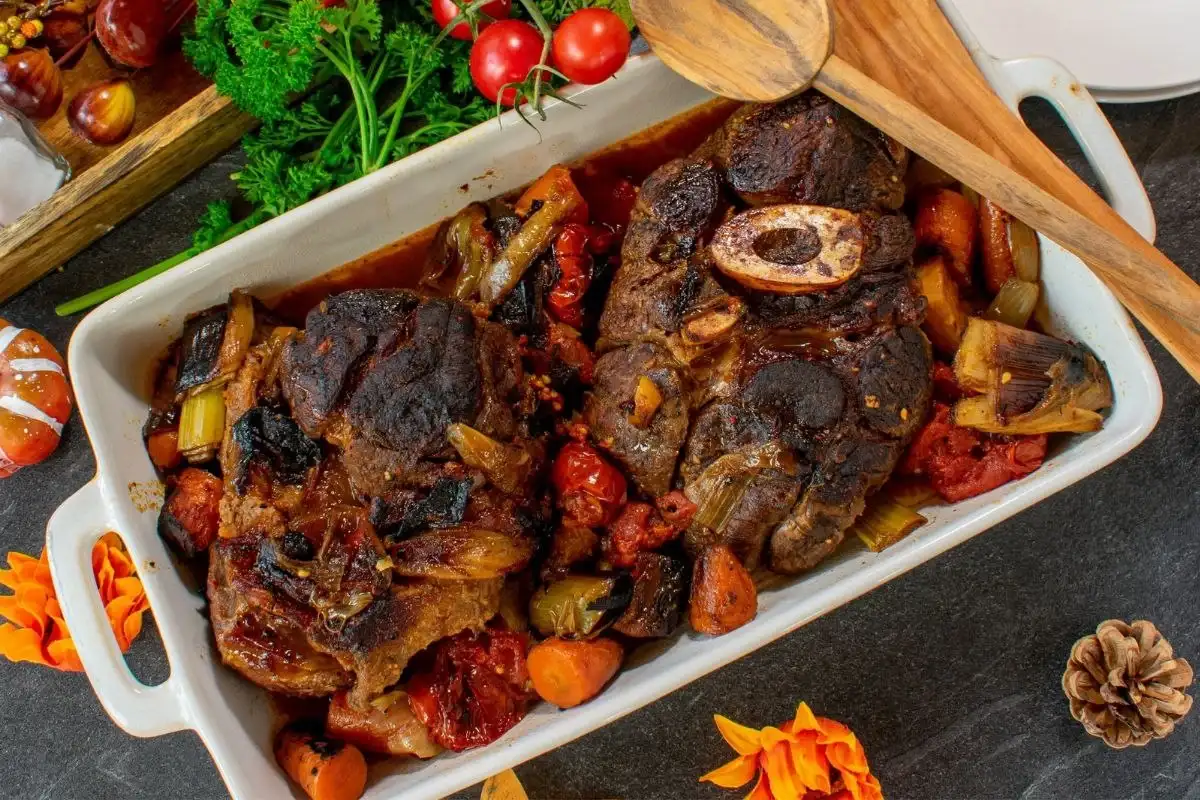
Introduction to Beef Shank Recipe
What is a Beef Shank?
Beef shank comes from the leg portion of a steer or heifer, which is one of the tougher different cuts of beef. Due to its location, it’s packed with connective tissues and muscle fibers that make it ideal for slow-cooking methods. When cooked properly, the beef shank recipe is not just tender but also rich in flavor, making it a prime choice for hearty meals.
In this revised version, “different cuts of beef” serves as the anchor text, linking to an informative page about beef cuts. Consequently, this integration provides additional information that is relevant to the context of beef shank’s position among other beef cuts, thereby enhancing the reader’s understanding.
Benefits of Cooking with Beef Shanks
One of the main attractions of cooking with beef shank is its affordability. This cut offers a budget-friendly option for families and individuals looking to enjoy beef without breaking the bank. Additionally, beef shanks are nutrient-rich, providing a good source of protein and essential minerals which contribute positively to a balanced diet.
Moreover, using beef shank in your recipes allows you to explore a variety of cooking techniques, from braising to slow cooking. These methods help in breaking down the tough fibers and transforming the shank into a succulent dish. The process of slow cooking enriches the flavors, ensuring that each bite is as delicious as it is nutritious.
In our next section, we’ll explore the essential ingredients and preparation techniques that lay the foundation for a perfect beef shank dish. Stay tuned for detailed insights into maximizing flavor while maintaining the simplicity of your recipes.
how to prepare beef shank?
Key Ingredients for a Flavorful Beef Shank
To begin your culinary adventure with beef shank, gathering the right ingredients is crucial. You’ll need:
- Beef shanks: Opt for thick cuts that are well-marbled with fat. This not only enhances the flavor but also contributes to the tenderness of the meat after cooking.
- Root vegetables: Common choices like onions, carrots, and celery form a classic mirepoix which serves as a flavor base.
- Tomatoes: Fresh or canned, tomatoes add a rich, slightly acidic taste that complements the robust flavor of the beef.
- Beef broth: It’s essential for braising, providing moisture and a flavorful medium in which the shank can cook slowly.
- Herbs: Fresh thyme and bay leaves add a subtle aroma and depth to the dish, infusing it with herbal notes that are hard to resist.
Preparing Beef Shanks for Cooking
Preparing beef shank properly is the first step to ensuring a successful dish. Here’s how to do it:
- Clean and trim: Start by cleaning the shanks thoroughly. Trim off any excess fat, which can be excessive with this cut, to balance the richness.
- Tying the meat: To preserve the shank’s shape throughout the extended cooking time, wrap it with kitchen twine. This ensures that it retains its form and cooks uniformly.
- Seasoning: Generously season the shank with salt and pepper. You can also rub it with a mix of dried herbs to introduce more flavors right from the start.
- Dredging: Lightly coat the shank in flour. This step is not just about thickening the sauce later on; it also helps in creating a beautiful sear that locks in flavors.
Now that you’ve prepped your ingredients and the beef shank, it’s time to move on to the cooking methods that will transform this tough cut into a tender delicacy. Next, we’ll delve into various techniques to cook the shank, focusing on braising and slow cooking to achieve that fall-off-the-bone texture. Stay tuned as we continue to uncover the secrets to mastering beef shank recipes.
How to Cook Beef Shanks?
Braising Beef Shanks
Braising is a moist-heat cooking method that tenderizes the beef shank by slowly cooking it in a covered pot with a small amount of liquid. Consequently, here’s how you can braise beef shanks to perfection:
- Brown the shanks: Begin by heating some olive oil in a heavy-bottomed pot or Dutch oven. Next, add the beef shanks and brown them on all sides. This step is crucial, as it significantly enhances the flavor of the meat.
- Sauté the vegetables: Remove the shanks and add your mirepoix (onion, carrots, and celery) to the same pot. Cook until they are soft and golden, adding layers of flavor.
- Deglaze: Return the shanks to the pot along with tomatoes and herbs. Pour in beef broth to deglaze the pot, scraping up any browned bits from the bottom.
- Slow cook: Place a lid on the pot and move it into an oven that has been preheated. Allow the shanks to simmer at a gentle heat for several hours until the meat becomes soft and begins to fall off the bone.
Slow Cooking Techniques
For those who prefer using a slow cooker, this method simplifies the process while ensuring delicious results:
- Prep the shank: After browning the shanks and sautéing the vegetables, transfer everything into the slow cooker.
- Layer the flavors: Add the tomatoes, herbs, and enough beef broth to cover the ingredients. The slow cooker will circulate the flavors and aromas, infusing the shanks with all the seasonings.
- Set and forget: Cover and set your slow cooker on low for 8-10 hours. The long, slow cooking process will gently break down the tough fibers in the shank.
Cooking in a Dutch Oven
Alternatively, a Dutch oven provides excellent heat distribution and retention, ideal for both braising and slow cooking:
- Assemble the ingredients: After browning the shanks and sautéing the vegetables, add all the ingredients back into the Dutch oven.
- Braise in the oven: Cover with a tight-fitting lid and place in an oven preheated to 325°F (163°C). Cook for about 2-3 hours, checking occasionally to ensure the meat becomes fork-tender.
By employing these methods, the tough beef shank is transformed into a tender, succulent dish that is bursting with flavor. Consequently, in the following section, we will explore various recipe variations to keep your beef shank dishes fresh and exciting. Therefore, stay tuned as we continue our journey through the culinary world of beef shanks.
Delicious Beef Shank Recipe Variations

Classic Braised Beef Shank Recipe
A traditional braised beef shank is a timeless dish that appeals to many. Here’s how to make it:
- Prepare the shank: Follow the initial steps outlined in the braising section to prepare and brown your beef shanks.
- Add aromatics and liquids: After sautéing the mirepoix and deglazing with beef broth, add a rich tomato base and a bouquet of herbs like thyme and bay leaves.
- Slow cook to perfection: Cover and let the shanks simmer in the oven at a low temperature for several hours until the meat is deliciously tender and the flavors meld together beautifully.
Beef Shank Stew Variations
Stewing is another fantastic way to enjoy beef shank. You can adapt the recipe by introducing various international ingredients:
- Mediterranean style: Incorporate olives, capers, and a splash of lemon juice for a bright, tangy stew.
- Eastern European influence: Add paprika, potatoes, and a dollop of sour cream for a hearty, comforting dish.
- Asian flair: Use soy sauce, star anise, and ginger to give the stew a warm, spicy depth.
International Twists on Beef Shank Recipes
Expanding your culinary horizons can transform the humble beef shank into a global gourmet experience:
- Italian Osso Buco: Instead of traditional veal, use beef shanks to make this Italian classic. Slow-cook with white wine, garlic, and anchovies for an authentic taste.
- French Pot-au-Feu: This simple yet elegant French stew uses beef shank along with root vegetables and bone marrow for a rich, flavorful broth.
- Mexican-style Barbacoa: Prepare the shanks with chipotle peppers, cumin, and lime for a dish full of zest and spice.
By exploring these variations, you can keep your meals exciting and introduce friends and family to the rich flavors that beef shanks have to offer. Subsequently, we’ll dive into some expert tips that will help you enhance these recipes and ensure your beef shank dishes are a hit every time. Furthermore, stay tuned for insider advice on choosing the right cuts, boosting flavors, and perfecting your presentation.
Expert Tips for Perfect Beef Shanks Every Time

Choosing the Right Cut
Choosing the correct cut of beef shank can greatly influence the success of your meal. Here are some guidelines to assist you in making an informed selection:
- Look for marbling: Good marbling (fat running through the meat) is essential as it melts during cooking, infusing the shank with moisture and flavor.
- Thickness matters: Choose shanks that are uniformly sliced and no less than two inches thick to guarantee even cooking and retain their juiciness.
- Ask your butcher: Don’t hesitate to seek advice from your local butcher. They can offer insights into the freshest cuts and even suggest the best pieces for your specific recipes.
Secrets to Enhancing Flavor
To elevate the taste of your beef shank dishes, consider these flavor-enhancing tips:
- Roast the bones: If your shank comes with a bone in, roasting it before adding it to the pot can add a deep, rich flavor to your broth.
- Use fresh herbs: While dried herbs are convenient, using fresh herbs like thyme and rosemary can provide a brighter, more vibrant flavor profile.
- Deglaze with broth: After browning the meat and sautéing the vegetables, deglaze the pan with beef broth instead of water. This not only lifts the caramelized bits for more flavor but also incorporates them into the sauce.
Serving Suggestions
How you serve your beef shank can turn a great dish into an unforgettable meal. Here are some serving tips:
- Pair with starch: Serve your beef shank over a bed of creamy mashed potatoes, polenta, or a simple risotto to soak up the delicious sauce and balance the richness of the meat.
- Add color and crunch: Brighten up your plate with some fresh, steamed green vegetables like asparagus or green beans. Their crisp texture and vibrant color provide a pleasing contrast to the tender meat.
- Garnish wisely: A sprinkle of freshly chopped parsley or a zest of lemon can add a fresh, clean finish to your hearty dish.
In the next section, we will cover the best practices for storing and reheating beef shanks, ensuring that your delicious creations stay as enjoyable as when they were first cooked. Stay tuned for these essential tips to make the most out of your culinary efforts.
Storing and Reheating Beef Shanks
Best Practices for Storage
Proper storage is crucial to maintaining the quality of your beef shank dishes. Here’s how to keep them fresh and delicious:
- Cool before storing: Allow the beef shanks to cool to room temperature before refrigerating. Placing hot food in the fridge can raise the internal temperature, potentially allowing harmful bacteria to grow.
- Airtight containers: Transfer the beef shanks and any sauce into airtight containers. This prevents them from absorbing odors from other foods in the fridge and also keeps them moist.
- Refrigeration: Properly stored, cooked beef shanks can last in the refrigerator for up to three to four days.
How to Reheat Beef Shanks
Reheating beef shank properly can help retain its tenderness and flavor. Follow these tips for best results:
- Slow and low: Reheat the shanks slowly on a low heat setting on the stove. Add a little beef broth or water to the pan to help keep the meat moist and to reinvigorate the sauce.
- Cover while reheating: Cover the pan with a lid to trap the steam and ensure even heating. This method prevents the shanks from drying out.
- Microwave with care: If you’re short on time, you can use the microwave. Place the shanks in a microwave-safe dish, add a splash of broth, and cover. Microwave on a low setting in short bursts, stirring in between to evenly distribute the heat.
Following these storage and reheating guidelines will help ensure that your beef shank remains as delectable as when it was first served. In our final section, we will address some frequently asked questions about cooking beef shanks, providing you with additional insights to enhance your cooking experience. Stay tuned for helpful answers to common queries and tips to perfect your beef shank preparations.
FAQs about beef shank recipe
Here are some frequently asked questions about the beef shank recipe to help you better understand how to select, prepare, and cook this flavorful cut of meat.
How Long Should Beef Shanks Be Cooked to Become Tender?
The key to tender beef shank is slow cooking. Typically, beef shanks should be cooked for at least two to three hours at a low temperature, either in the oven or on the stove. If using a slow cooker, they can take between six to eight hours on low heat. The exact time can vary based on the size of the shank and the cooking method, but the meat should be fork-tender when done.
how long to cook beef shank in oven
To cook beef shank in the oven until tender, preheat the oven to 325°F (163°C). Brown the shank, add liquids and aromatics, and cover the pot. Bake for about 2 to 3 hours, or until the meat is fork-tender. Check after 2 hours and adjust time as needed.
Can I Fry Beef Shanks?
Frying is not the recommended method for cooking beef shanks, as it doesn’t allow the tough fibers and connective tissues to break down adequately. However, browning the shanks in a hot pan before slow cooking can add depth and richness to the flavor. This process, known as searing, creates a caramelized crust that enhances the final dish.
where to buy beef shank?
You can purchase beef shank at local butchers, grocery stores, specialty meat shops, farmers’ markets, online meat suppliers, and ethnic markets. Therefore, select a source based on your preferences for meat quality and sourcing.
What Are the Best Sides to Serve with Beef Shanks?
Beef shank dishes are rich and hearty, making them well-suited to a variety of sides. Some of the best options include:
- Starchy sides: Mashed potatoes, creamy polenta, or risotto are excellent for soaking up the delicious sauce.
- Vegetables: Bright, steamed vegetables such as carrots, broccoli, or green beans add color and balance to the dish.
- Breads: A crusty loaf of bread or some soft dinner rolls can also be great for dipping into the sauce and enjoying every last bit.
This comprehensive guide to cooking beef shank covers everything from selecting the right cuts to preparing and cooking them to perfection, along with tips for storage and reheating. With the recipes and techniques discussed, you can create a variety of delicious dishes that showcase this versatile and economical cut of meat. Whether you’re cooking for a special occasion or a simple family dinner, beef shanks provide a satisfying and flavorful option that’s sure to impress.
Further Reading and Resources
To enhance your cooking experience and knowledge, consider these informative resources that complement your beef shank recipe preparation:
- Beef Nutrition Facts:
- Health Benefits of Beef – Learn about the nutritional value and health benefits of beef, including how beef shank fits into a healthy diet.
- Dutch Oven Care Tips:
- Using a Dutch Oven – Discover essential tips for maintaining and maximizing the use of a Dutch oven, which is ideal for cooking beef shank.
- Wine Pairing Guide:
- Pairing Wine with Beef – Explore recommendations for selecting the right wine to complement the rich flavors of beef, enhancing both your meal and dining experience.
These links offer valuable insights that can help you better understand the components of cooking beef shank, ranging from nutritional aspects to cooking tools and beverage pairings. Consequently, they enhance your overall cooking experience by providing a comprehensive understanding of each element involved.